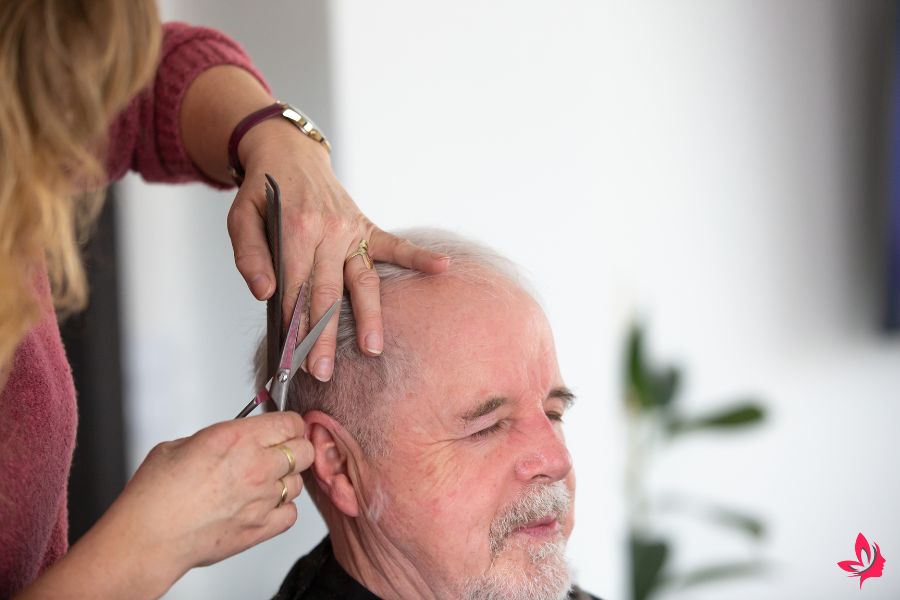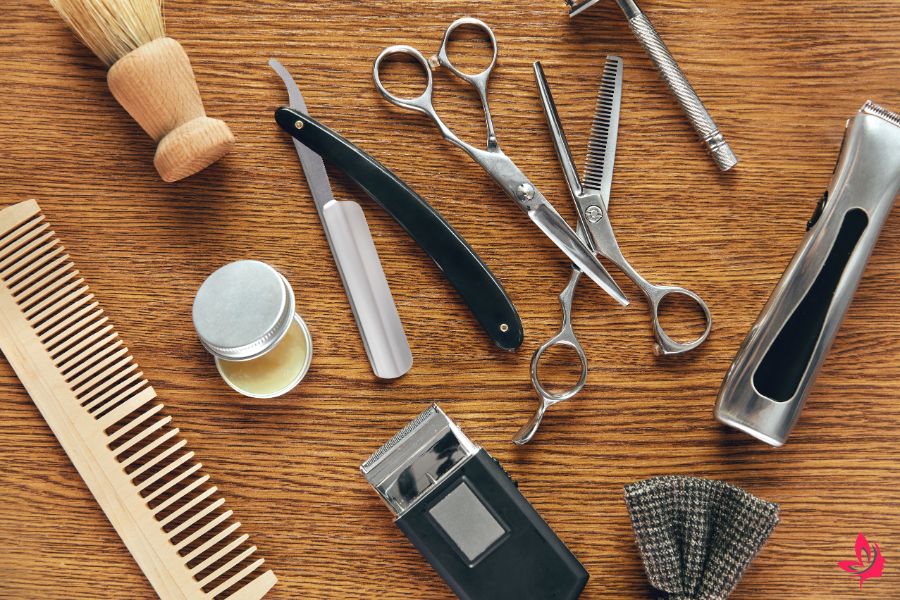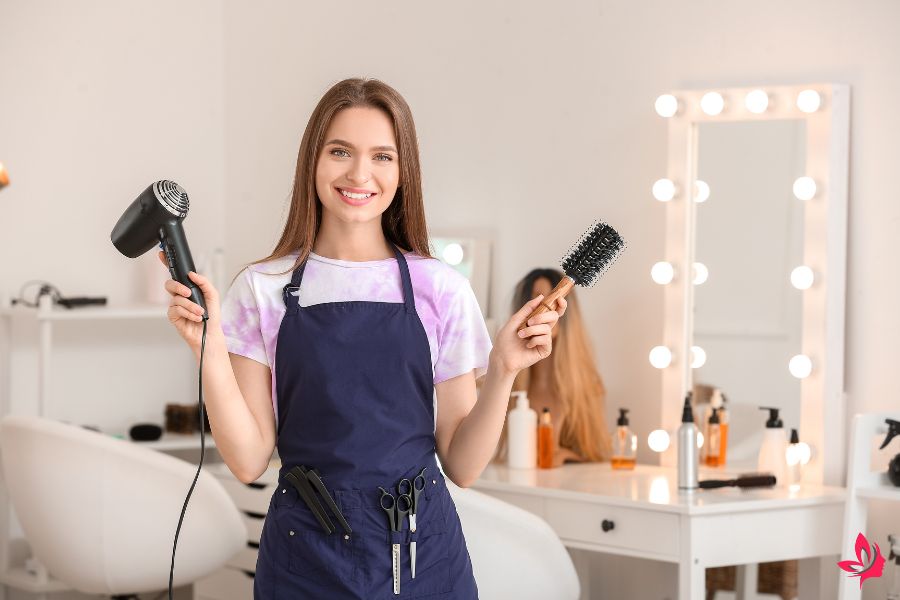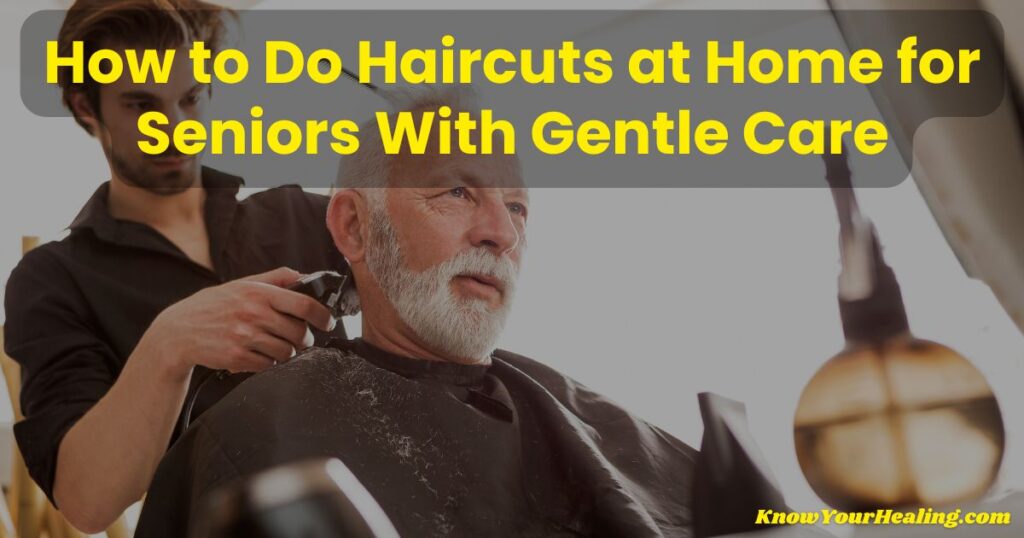Haircuts at home for seniors can feel intimidating at first. However, with the right approach and a gentle touch, family members can offer safe and comfortable grooming that preserves dignity and independence.
Many seniors struggle with mobility or anxiety about salons. Learning to give home haircuts is a valuable skill that caregivers should have in their toolbox.
With the proper techniques, seniors can enjoy quality grooming while staying comfortable in familiar surroundings—whether they do it themselves or bring in a mobile hair stylist.
This guide lays out everything you need for gentle, professional-quality haircuts at home. We’ll walk through setting up the right environment, picking the best tools, and step-by-step techniques for aging hair.
Whether you want to cut hair yourself or find professional at-home hair services, you’ll find practical ideas here that put comfort and safety first—while helping seniors look and feel their best.
Preparing for Haircuts at Home for Seniors the Right Way

Cutting seniors’ hair at home requires some planning for comfort and safety. Preparation involves understanding personal needs, selecting the right assistance, and setting up a space that accommodates mobility and various hair types.
Understanding the Needs of Senior Citizens Before a Haircut
Seniors often need a different approach than younger folks. Many take medications that change hair texture or growth. Some individuals have sensitive scalps or skin conditions that require extra care.
Think about cognitive needs, too. Seniors with dementia or Alzheimer’s might get anxious during grooming. It helps to schedule haircuts when they’re most alert—usually in the morning or after a good meal.
Check for physical comfort before starting. Does the senior prefer sitting upright or need frequent breaks? Are there tender spots on the scalp or neck?
Key health factors to consider:
- Current medications affecting hair growth
- Scalp conditions or allergies
- Past negative experiences at salons
- Preferred hair washing routine
- Comfort level with touch and grooming
Communication styles vary. Some seniors prefer to hear each step explained; others want a quiet, efficient trim. It’s worth asking what makes them most comfortable.
Choosing the Right Hair Stylist or Mobile Hairdresser for Seniors
Mobile hairdressers who work with seniors bring a unique set of skills to the table. Look for stylists who understand age-related hair changes and have patience with clients who may have mobility challenges.
Always check their credentials and insurance before booking. Licensed cosmetologists should have liability insurance and up-to-date certifications. Ask about their experience specifically with seniors.
Don’t be shy about requesting references from other senior clients or caregivers. A skilled mobile hairstylist will be happy to share stories about their gentle approach.
Qualifications to check:
- Current cosmetology license
- Experience or training in senior care
- First aid certification
- Background check
- Professional insurance
Schedule a consultation before your first haircut. This gives everyone a chance to meet and discuss preferences without any pressure. Many mobile hair services offer short meet-and-greet visits.
Matching Hair Type to the Best Cut and Style Options
Hair type significantly influences the styles that work best for seniors. Fine hair usually does better with shorter cuts that add volume and reduce styling time. Thick hair often needs layering to lighten the load and make it easier to handle.
Curly hair tends to get even more textured with age. Gentle cuts that follow the natural curl can help prevent frizz and simplify styling.
Consider the level of maintenance a style requires. Seniors with limited arm mobility will appreciate cuts that look good with just a brush or a quick finger-comb. Pixie cuts and bobs are often ideal for those with low-maintenance needs.
Hair type tips:
- Fine hair: Short layers, gentle volume
- Thick hair: Thinning, strategic layering
- Curly hair: Dry cutting, curl-friendly shapes
- Gray hair: Styles that highlight silver tones
Be honest about styling abilities. A good haircut should look tidy even without fancy tools or products.
Creating Comfort in Their Own Home for a Relaxed Experience
There’s an exceptional comfort in getting a haircut at home. Familiar surroundings help ease anxiety and eliminate the hassle of transportation.
Position near a window for optimal natural light. Use a sturdy, comfortable chair with back support. Keep the area clear of carpet, and lay towels on the floor to catch any hair.
Make sure the room feels warm enough, especially if you’ll be using water. Seniors tend to get chilly quickly, so keep a blanket handy, just in case.
Home setup checklist:
- Chair with armrests
- Bright lighting (natural is best)
- Easy-to-clean floor
- Towels and a cape
- Mirror for checking progress
Try to minimize distractions—turn off loud TVs and silence your phone. Soft background music can help set a calm, spa-like mood.
Addressing Mobility Challenges Before Starting the Senior Haircut
Mobility issues mean you’ll need to plan for safety and comfort. Seniors in wheelchairs often require stylists familiar with adaptive positioning techniques.
Limited neck mobility can make shampooing tricky. Consider dry shampoo or waterless cleansers. Some seniors skip washing before a cut to avoid neck strain.
Plan for breaks during longer sessions. Sitting still can get uncomfortable fast for anyone dealing with arthritis or joint pain.
Mobility tips:
- Wheelchair-accessible setup
- Neck support pillows
- Frequent position changes
- Shorter appointment times
- Adaptive tools as needed
If transfers are needed, coordinate with caregivers in advance. Safety always comes first—never rush the process.
Step-by-Step Guide to Gentle Home Haircuts for Seniors

Giving a senior a haircut at home requires preparation, gentle technique, and a bit of planning. Mobile hairstylists and specialized tools can make the process smoother for those with mobility issues.
Setting Up In-Home Hair Care Tools and Equipment
Senior citizens benefit from specific tools for safe at-home haircuts. Begin with sharp, lightweight scissors specifically designed for cutting hair. Dull blades can tug and damage delicate strands.
Here’s what you’ll need:
- Hair cutting scissors (5-6 inches)
- Wide-tooth comb for detangling
- Spray bottle with water
- Cape or towel for clothing protection
- Good lighting or a portable lamp
- Comfortable chair with back support
Set the chair near a window if possible. Keep all tools within arm’s reach on a stable surface. Always test scissors on a small section first to ensure they are sharp.
Use non-slip mats underfoot, and clear away anything that could cause a fall.
Techniques for a Great Haircut for Fine Hair or Curly Hair
Fine hair and curly hair need different techniques. For fine hair, dampen it and cut small sections at a time. This helps avoid cutting off too much and keeps volume intact.
Fine Hair Tips:
- Cut vertically, not straight across
- Start longer—you can always trim more
- Use point-cutting for softer edges
- Skip thinning shears
Curly Hair Tips:
- Cut curls dry
- Follow the natural curl pattern
- Trim each curl individually
- Don’t pull curls straight while cutting
Go slow and cut less than you think. Hair grows about half an inch a month, so it takes some time to correct mistakes. The pixie cut features gentle layers that suit a wide range of hair types.
How to Plan the Next Haircut regularly
Scheduling the next haircut keeps hair from getting out of control. The best timing depends on hair growth and the style you want to maintain.
General schedule:
- Shortcuts: Every 4–6 weeks
- Medium length: Every 6–8 weeks
- Long hair: Every 8–10 weeks
Mark appointments on the calendar to stay on track. Consistent trims keep hair healthier and easier to manage.
Jot down what worked after each cut. Note which techniques worked best and where you might need to make adjustments next time.
Don’t forget that weather matters—humidity or indoor heating can change how hair behaves from season to season.
Using At-Home Hairstylists and Mobile Hairstylists for Quality Services
Mobile hairstylists bring salon services right to seniors’ homes. They offer expertise and attention that family members may not be able to provide.
Why choose mobile hair services?
- Professional training
- Quality tools and equipment
- Knowledge of senior-friendly styles
- Experience with mobility issues
Look up local options online or ask senior communities for recommendations. Always confirm licenses and insurance before booking.
Expect to pay $50–$100 per visit, depending on your location and the specific services required. Some stylists accept Medicare or insurance if grooming is medically necessary.
Book appointments when the senior feels most comfortable—mornings usually work well.
Ensuring Comfort of Their Home for Seniors in a Senior Living Community
Residents in senior living communities often require additional planning for in-home haircuts. Activities directors often help coordinate mobile beauty services for those who want to stay in their own space.
Community tips:
- Coordinate with staff
- Make sure rooms have good ventilation
- Follow community health rules
- Schedule around meals and activities
Some facilities have special rooms just for hair services. These usually have better lighting and more space than regular rooms.
If a resident has medical needs, please discuss them with the nursing staff before the haircut. It’s always better to be safe and prepared.
Finding the Best Home Haircut Services for Senior Citizens

Haircuts at home for seniors offer a practical alternative when getting to a salon isn’t easy. Mobile hairdressers offer personalized care, taking into account the mobility and health needs that many older adults face.
Comparing Local Options for Mobile Hair Services and Salon Services
Senior citizens have several solid options for hair care. Traditional salons often require a trip out and can create accessibility challenges for those with mobility issues.
Mobile hair services flip the script by sending professional stylists right to the client’s door. Prices typically range from $50 to $100 per visit, depending on the complexity of the haircut and your local rates.
Salon services still have their fans, but they mean traveling—and that can be tough. Some salons offer 10-20% senior discounts on weekdays, but additional costs, such as transportation and the effort involved, can quickly eat up those savings.
Mobile haircuts for seniors directories make it easier for families to find trusted professionals in their area. These sites usually list reviews and prices to help you compare your options.
How a Great Clips Stylist or Mobile Stylist Can Save a Lot of Money
Mobile stylists can help families cut costs compared to traditional salon visits. Transportation—such as gas, parking, or ride-sharing—often adds $15 to $30 per salon trip.
Great Clips stylists charge about $15-$25 for a basic cut. Mobile stylists usually charge $60-$80, but they save families time and the hassle of arranging rides.
Cost breakdown comparison:
- Traditional salon: $25 haircut + $20 transportation = $45 total
- Mobile service: $70 haircut, no extra costs
Convenience matters for busy families. In-home hair stylists for seniors can reduce the entire process from 2-3 hours to just 45 minutes.
Benefits of Mobile Beauty Services for Seniors With Health Conditions
Seniors dealing with health issues often find that mobile beauty services make life easier. If someone’s living with dementia, arthritis, or heart problems, being at home can feel much less stressful.
Mobile hairstylists are skilled in working with clients who use oxygen tanks, wheelchairs, or other specialized equipment. They adapt to limited mobility and sensitivities, making the experience more comfortable.
Key health benefits include:
- Less risk of catching germs in public
- Familiar spaces can help reduce confusion
- No extra strain from traveling
- Flexible scheduling around doctor visits
At-home haircuts are safer for seniors during recovery or when their immune systems are weakened.
Choosing a Haircut Service That Offers Individual Attention
Individual attention makes a significant difference for seniors who need haircuts. Physical challenges or unique hair types often require extra time.
Good mobile stylists spend 60-90 minutes per visit, taking the time for a thorough consultation and meticulous work. Salons can feel rushed by comparison.
Factors indicating good individual attention:
- Consultation calls before the appointment
- Willingness to work with caregivers
- Experience with seniors’ specific needs
- Flexible appointment lengths
Professional mobile stylists understand that curly, fine, or thinning hair requires different care. They adjust for the effects of medication on hair texture.
Why Mobile Service and Mobile Haircut Options Are a Convenient Solution
Mobile services remove many barriers that prevent seniors from receiving regular haircuts. Bad weather, lack of rides, or low energy don’t have to get in the way anymore.
In-home hair care allows seniors to maintain their appearance without relying on family for a lift. That independence can lift spirits and boost self-esteem.
Convenience factors include:
- Same-day or next-day appointments
- Service in pajamas or whatever’s comfy
- No crowded waiting rooms
- Access to your bathroom and mirror
Mobile haircut services are also well-suited for senior living communities. Scheduling several residents on one day can lower the cost for everyone.
Frequently Asked Questions
Senior haircut services at home provide a convenient and straightforward way for older adults to receive gentle hair care. People often have questions about mobile stylists, safe techniques, and how these services work.
Yes, professional mobile hair stylists for seniors can come to your home for affordable, safe haircuts. These pros bring salon-quality service right to your door.
Licensed beauticians and barbers have special training to work with older adults. They understand the mobility and health issues that can come up.
Many companies now offer at-home hair stylists and barbers who know how to care for seniors. They bring portable gear and use gentle methods.
The 3-2-1 rule helps keep home haircuts even and balanced. It means dividing the hair into three main sections, checking twice before cutting, and performing a final trim at the end.
This method is particularly suitable for seniors who require careful, gentle cuts. Professional stylists often use it for at-home appointments to avoid uneven results.
Short, layered cuts typically work best for seniors—they can add volume to thinning hair and are easier to manage on a day-to-day basis.
Classic bobs and pixie cuts are popular, offering a fresh and youthful look. Soft waves and gentle layers can help disguise hair loss, creating a natural appearance.
Anti-aging haircuts for seniors accentuate facial features and complement your natural texture. Most stylists recommend trims every 6 to 8 weeks to keep the ends of the hair healthy.
Start with clean, damp hair and use sharp scissors made for cutting hair. Work in small sections and always cut less than you think—you can trim more if needed.
It’s best to cut when the hair is slightly wet, not soaking wet, for more control. This helps avoid uneven spots and frizzy flyaways.
For seniors, handle their hair gently, as it becomes more fragile with age. Use a wide-tooth comb and avoid pulling or tugging as you cut.
Female mobile hairstylists offer at-home haircuts for seniors as a comfortable option. Many women prefer female stylists for the sake of privacy and comfort.
Licensed female beauticians provide the same professional service you’d get in a salon. They bring all the necessary tools and products directly to your home.
These services are beneficial for senior women with mobility or transportation issues. Female stylists often possess the best knowledge of age-appropriate styles and techniques.
Licensed hairdressers can legally cut hair in clients’ homes in most places. They need to keep their licenses up to date and follow local health regulations for mobile services.
Professional hairdressers bring portable chairs, tools, and cleaning supplies to their workstations. They maintain a sanitary environment and adequately dispose of hair clippings.
Many hairdressers now specialize in training for the hair care of elderly adults at home. They learn about the effects of medication on hair and how to assist clients with limited mobility.
Cutting your hair at home can lead to uneven results or mistakes that are hard to fix. Seniors should be extra cautious due to vision or hand steadiness issues.
Professional stylists have the training to avoid common mistakes. They understand how hair grows and which shapes complement different facial features.
For seniors, professional haircuts at home are usually safer than self-cutting. Mobile stylists bring expertise, allowing you to stay comfortable at home.
Tipping mobile hairstylists is similar to salon tipping—usually 15-20% of the service price. Some folks tip a bit more for the convenience of home service.
Some stylists include gratuity in their fees, so it’s best to ask about their tipping policy. Cash tips are often preferred over adding it to a card.
If you’re a regular client, consistent tipping can help build a good relationship. That might mean better appointment times or more personalized service.
Cutting your hair takes steady hands, good eyesight, and the right scissors—which some seniors might not have. Simple trims are possible, but bigger cuts are better left to the pros.
Female seniors often struggle to reach the back of their head, and conditions like arthritis can make it even tougher.
Caregiver tips for elderly hair care suggest that family or professional help is usually safer than self-cutting for senior women.
Start by washing your hair, then gently towel-dry it until it’s damp but not dripping wet. Divide your hair into small, manageable sections using clips or hair ties.
Work from the back and move toward the front, trimming just a little at a time. Grab a pair of sharp hairdressing scissors and snip at a slight upward angle—this helps create soft, natural-looking layers.
If you’re a senior, you may want to consider asking for help or exploring professional haircuts for seniors available at home. Issues like limited vision or mobility can make self-cutting risky, and, honestly, it’s not worth the risk of a bad haircut or an accident.



